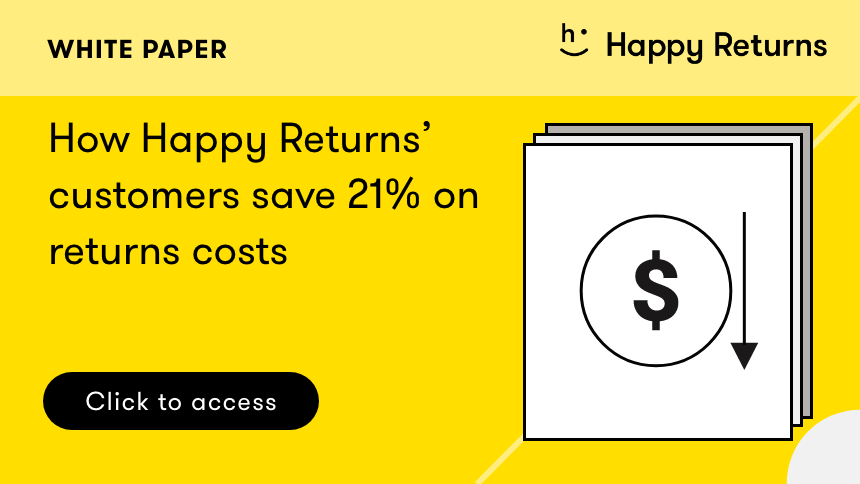E-commerce holiday returns: It's not too late to...
Holidays are expensive. While it’s the busiest selling season of the year for most merchants, the National Retail Federation (NRF) estimates that nearly 18% of all holiday purchases across product types will be returned—costing merchants roughly $171 billion. In recent years, many merchants have been looking for new strategies to offset the high cost of e-commerce returns. Enter return fees.
Last year, 16% of merchants that participated in our annual survey planned to start charging for returns in 2023. However, based on this year’s data, 81% said they had implemented return fees after all, highlighting the urgency to recoup revenue from increasing return rates.
Now, with holiday sales underway (a phenomenon that seems to begin right after back-to-school sales these days), there are still a number of simple steps retailers can still take so that returns don’t swallow this year’s holiday revenue.
Good return policies can reduce friction
Return policies matter to shoppers – even before they browse. In fact, 81% of shoppers review return policies before shopping with a merchant for the first time and 61% are even more likely to consider return policies before making a holiday purchase online.
Merchants that provide clear, concise return policies right out of the gate may win over customers before they even start to shop. An easy-to-access and easy-to-understand return policy may boost shoppers’ confidence and turn browsers into buyers.
Be consistent throughout the shopper journey
More than half (55%) of shoppers say they’ve abandoned a purchase because the return policy didn’t offer a convenient return option.
If shoppers already have products in their cart, but only then realize the return policy isn’t satisfactory, not only can that shopper experience sacrifice a sale, but it can also turn a shopper off for good.
Include return policy details on product detail pages and in customer communications throughout the season and into the new year. Be transparent—especially if there are seasonal changes. Use communications to demonstrate customer-centricity and reliability.
Give the gift of convenient return options
A focus on convenient return methods goes a long way towards meeting shoppers’ preferences too. Shoppers overwhelmingly prefer in-person returns and 90% try to avoid or refrain from shopping with merchants that require mail returns.
That’s a huge departure from shoppers accepting mail returns as the default method. As David Sobie, co-founder and CEO of Happy Returns, a UPS company, recently stated:
“Mail-in returns are a thing of the past. Please don't make me print a label. Don't make me find a box. Don't make me tape up the box. And then most importantly, once I have prepared my arts and crafts projects and put it in the mail, my reward is to then go back and check my credit card statements in the next two or three weeks and hope that I get my refund or hope that my exchange gets triggered? Please don't make me go through that process.”
Offering hassle-free return methods gives shoppers the gift of flexibility and convenience. A good return policy can lead to repeat business. It isn’t meant to incentivize more returns, but it does improve shoppers’ overall experience. And that makes future sales worth it.
By the way: Providing a variety of options at different price points can help merchants influence how shoppers make a return, often guiding them to choose the most affordable option for both the shopper and the merchant.
For example, charging for more expensive return options like mail returns, but offering in-person returns at third-party drop-off locations for free, can help merchants offset high return costs while also providing more desirable return methods to shoppers. Some already are: 59% of merchants that implemented return fees saw an increase in shoppers opting for the free method they offer. It’s a win-win.
Happy returns, happy shoppers, happy holidays
Returns happen, especially as e-commerce sales continue to grow. And the holidays are hectic enough. By continuing to evolve return policies, you can help alleviate some of the stress of Q4. But it doesn’t stop there. Here are a few other ways to uplevel your return policy and process while meeting (and exceeding) shoppers' expectations:
Beyond transparent return policies, make it super simple to initiate a return or exchange
Add incentives during the returns experience to boost exchange rates or return for site credit, like discounts on future purchases or waiving shipping fees
Extend your return and/or exchange windows into the new year to add even more flexibility and convenience for shoppers during the holiday rush
And again, implement return fees thoughtfully – identify what shoppers want and find a strategically beneficial way to give it to them. Maybe a good New Years’ resolution?
Don’t miss! Download the new 2023 Returns Happen report to see what shoppers look for in a return policy and how merchants are responding. Set your teams up for success in the new year – it's bound to be a pivotal year for e-commerce returns.
Sources:
Worldwide Business Research (WBR), commissioned by PayPal, December 8, 2022 - January 17, 2023. The phone interview was conducted by WBR across 100 U.S. apparel and footwear merchants with annual revenues of $500 million or more (n=100).
Worldwide Business Research (WBR), commissioned by PayPal, December 8, 2022 - January 17, 2023. The phone interview was conducted by WBR across 100 U.S. apparel and footwear merchants with annual revenues of $500 million or more (n=100).
TRC, commissioned by PayPal, September 8-19, 2022. The research was conducted by TRC, with fieldwork administered by Forsta across 2,002 U.S. consumers who returned an online purchase within the past year. (n=2,002)






